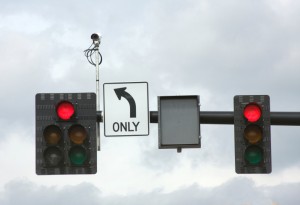What’s next if Ohio ends red light cameras?

By Maggie Thurber | For Ohio Watchdog
Ohioans have been struggling with the issue of red light cameras for more than a decade, but the debate may soon be over.
CAMERA BAN? With the passage of a Senate bill, Ohio may soon effectively ban red light and speeding cameras.
Senate Bill 342 was passed Wednesday and sent to the House for concurrence, where it is expected to be approved and sent to the governor for his signature.
The Senate bill doesn’t ban the cameras — it regulates them.
It requires a law enforcement officer to witness any violation caught by a camera and issue a traditional traffic ticket to the driver, rather than the owner of the vehicle.
Opponents say this will effectively end the use of red light or speed cameras in the state and result in increased accidents at targeted intersections.
But Sen. Bill Seitz, R-Cincinnati, the sponsor of the bill, says the cameras are less about safety and more about money and increased revenue for municipalities — a perception many Ohioans and drivers share.
That perception probably influenced voters in Cleveland and Maple Heights, who overwhelmingly passed a measure on Nov. 4 that requires an officer to write a ticket resulting from a camera.
Add to this the pending decision from the Ohio Supreme Court in a case that challenges the administrative hearing process so many of the cities established to bypass the local municipal courts, and the writing appears to be on the wall.
If the bill passes and the Supreme Court decides against the cities, what happens next?
The cameras, hopefully, will go away.
And the cities can stop pretending when it comes to traffic safety and actually do something about it.
When the cameras were first introduced, they were supposed to be placed at intersections with high rates of T-bone crashes caused by motorists running a red light.
At first, there were a lot of citations, with the city and camera company splitting the fine money. In some cases, the private company got more than 50 percent.
But people got used to the cameras and the fine money declined.
Rather than rejoice in the fact that drivers were no longer running red lights, the decline in revenue was seen as a problem that needed to be fixed.
Clearly, the only reason people weren’t getting caught running the red light was because they were speeding up to zip through the targeted intersections. So along came speed cameras — and revenue went back up.
But then a strange thing happened. Drivers started getting into rear-end crashes from stopping suddenly to avoid the speeding and red-light infractions. Not to worry, the politicians said, those rear-end crashes were less dangerous than the T-bone ones, so it was OK.
As time went on, people either stopped speeding, running red lights or just avoided the intersections altogether, and the inevitable decline in revenue was again an issue.
But cities and camera companies didn’t want the gravy train to stop. Citing alleged increased safety, which was the only conclusion one could reach from a decline in violations, they added new locations based upon the likelihood that red light violations might occur. Actual proof of accidents was no longer necessary to justify a camera.
But again, revenue declined so companies came up with stop sign cameras and railroad crossing cameras. Money, not safety, was the priority.
It was a great deal for the politicians. After all, what’s not to love about a company selling jurisdictions on their product and promising a share of the proceeds if the politicians will buy into the deal?
It’s a wonder someone didn’t define it as a predatory camera scheme. It’s not that much different from the predatory tow trucks, predatory pay-day lenders and predatory bankers so many complain about.
Throughout the money grab and cozy crony capitalistic process, the intersections remained the same.
The intersections haven’t been evaluated, as the National Highway Traffic Safety Administration recommends, to see what the cause of the dangers are. Cities didn’t even conduct traffic counts to find out if increased traffic volumes might be impacting the safety of an intersection.
There are a lot of things municipalities can do to identify what creates an intersection and plenty of ways, other than profiting off the problem, to address the issue.
But that would require time and effort and, yes, money.
Without the pretense of safety the cameras provide, will cities now turn to scientific evaluations of the intersections, as they should have done in the first place?
It’s a lot harder than allowing some company to put up a camera and rake in the dough, but it’s the right thing to do — if their claims about safety are to be believed.







